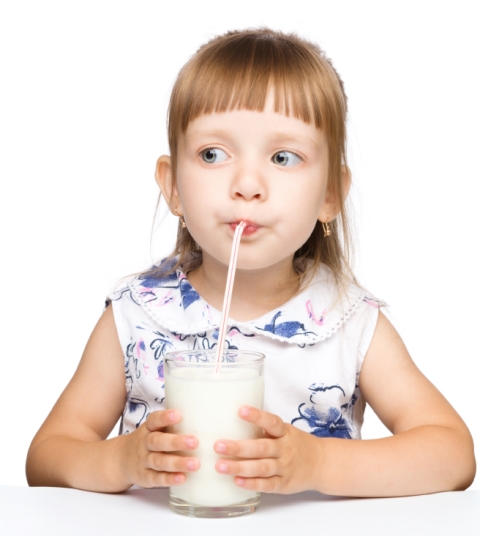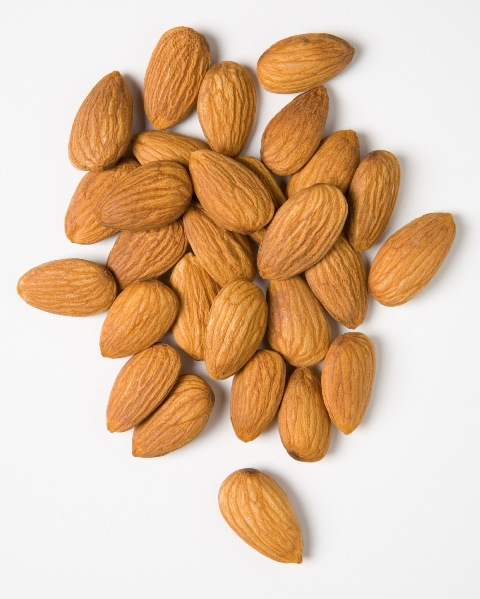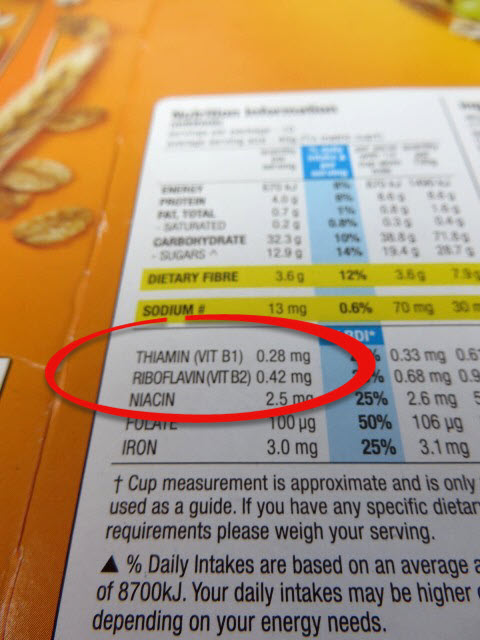- Home
- Blog
- Healthy Eating for Wellness
- What is riboflavin (vitamin B2)?
What is riboflavin (vitamin B2)?
Written by Catherine Saxelby
on Wednesday, 26 November 2014.
Tagged: bread, breakfast cereals, energy, grains, vitamins

Riboflavin, also known as vitamin B2, as it was the second substance shown to be essential for human health (after Vitamin B1), is a water-soluble vitamin. It is the vitamin responsible for the yellow-orange colour of fizzy multi-B vitamin supplements and for turning your urine a bright yellow-green colour.
The word "riboflavin" itself comes from two roots - "ribose" (a sugar which is present in its reduced form, ribitol, to form part of the structure of riboflavin) and "flavin", the second part of the vitamin molecule which imparts the yellow colour (from the Latin flavus meaning "yellow").
What does riboflavin do in the body?
Riboflavin performs many important functions. It
- is an integral component of two enzyme co-factors which are needed by numerous metabolic pathways in your body. A co-factor is a compound without which an enzyme can’t work.
- is important in the production of energy from food
- takes part in the metabolism of carbohydrates, proteins and fats and
- promotes healthy skin and eyes
How much riboflavin or vitamin B2 do I need?
Riboflavin is related closely to energy metabolism.
The Recommended Dietary Intakes* (RDIs) for riboflavin per day are:

Infants
0.3 mg for infants (0-6 months)
0.4 mg for infants (7-12 months)
Children
0.5 mg for children (1-3 years)
0.9 mg for children (9-13 years)
0.6 mg for children (4-8 years)
Older children
1.1 mg for girls (14-18 years)
1.3 mg for boys (14-18 years)
Women
1.1 mg for women (19-70 years)
1.3 mg for women (>70 years)
Men
1.3 mg for men (19-70 years)
1.6 mg for men (>70 years)
mg means milligrams
* (NHMRC Australia 2006)
Safe upper limit for riboflavin
This cannot be estimated precisely but 100 mg a day is considered a prudent maximum intake. That said, it is difficult to suffer from too much riboflavin because, being water soluble, any excess is excreted via your urine – hence the “day-glo” yellow effect commonly seen after taking B complex 50 or 100 mg supplements.
Riboflavin is not stored in the body, except for a small quantity in the liver and kidneys, so it is needed regularly in the diet.
List of the best riboflavin-rich food sources
Riboflavin is found in many of the foods that contain other B vitamins, notably milk, cheese, yeast, organ meats or offal such as liver and kidneys, whole (unrefined) grains e.g. millet and wild rice, mushrooms, and nuts, especially almonds. It’s one of the B vitamins commonly added to fortified breakfast cereals, malted milk powders and meal replacement drinks or diet shakes.
My top 20 sources
Here’s a list of the top 20 riboflavin-rich foods, both natural and fortified, ordered by concentration by weight per 100g/3 oz in descending order:
- Yeast extract spreads e.g. Vegemite, Promite, Marmite, Ozemite
- Beef, lamb or veal liver
- Malted milk powder (fortified with vitamin B2)
- Beef kidney
- Breakfast cereals fortified with vitamin B2
- Muesli bar with milk solids e.g. yoghurt-coated
- Skim milk powder
- Whole almonds
- Decaffeinated instant coffee powder
- Carob bar
- Chilli powder
- Reduced-fat cows feta cheese
- Grilled mushrooms
- Lean venison strips, grilled
- Reduced fat canned evaporated milk
- Cheddar cheese, processed
- Wheat germ
- Eggs
- Smoked oysters and mussels, canned in oil and drained
- Camembert cheese
Source: NUTTAB 2010
Is riboflavin lost during cooking?
Not much. Only a little of the riboflavin in foods is lost in the cooking water. However riboflavin is highly sensitive to light, which is why milk – a major source - is best stored in non-clear containers or away from light.
Riboflavin can be used as a natural orange food colour and you’ll see it on food ingredient lists as the additive number 101 (or in Europe as E101).
Easy ways get your recommended day's intake of over 1 mg

It’s relatively easy to get enough riboflavin as the vitamin is added to many cereals. Riboflavin is one of four vitamins added to most fortified products. Look for the word ‘RIBOFLAVIN’ under the Vitamins on the Ingredient List on a food label.
Most breakfast cereals are fortified with riboflavin at the level of 0.42 mg per bowl or cup.
Smaller amounts in many different foods all add up over a day to meet your RDI. Refined foods such as sugar, oils and many processed foods have little or none.
|
20 g Serve of All-Bran (0.2), 20 g Special K (0.5), 100 g Greek plain yoghurt (0.27) and 125 mL reduced-fat milk (0.27) |
1.24 mg |
|
Bowl of 50 g untoasted muesli (0.25) with 1 cup milk (0.6) and 25 g almonds with skin (0.35) |
1.2 mg |
|
150 g grilled lamb (0.52), 1 cup steamed broccoli (0.37) and ½ cup grilled mushrooms (0.45) |
1.2 mg |
|
Tub of 200 g natural yoghurt full-fat (0.5) and 50 g handful of almonds with skin (0.7) |
1.2 mg |
|
2 large eggs (0.42) with 1 cup grilled mushrooms (0.6) and ½ cup spinach steamed (0.18) |
1.2 mg |
Riboflavin deficiency signs
Deficiency rarely happens on its own – it’s always accompanied by a deficiency of other water-soluble vitamins. Here are the telltale signs:
- Sore throat
- Cracked and red lips
- Inflammation and redness of the tongue and mouth (magenta tongue)
- Cracks or sores on the corners of the lips (cheliosis)
- Mouth ulcers
- Moist and scaly skin inflammation (seborrheic dermatitis)
- Formation of blood vessels in the clear covering of the eyes which may become bloodshot, itchy, watery or sensitive to bright light
- Fluid in the mucous membranes
- Decreased red blood cell count and anaemia
- Fatigue and/or dizziness
- Nervous tissue damage
- Retarded growth in infants and children.
Severe riboflavin deficiency may result in decreased conversion of vitamin B6 to its coenzyme form and decreased conversion of tryptophan to niacin (vitamin B3).
You may also be interested in...
Foodwatch
The Good Stuff
The Boring Stuff
© 2025 Foodwatch Australia. All rights reserved
Website by Joomstore eCommerce





